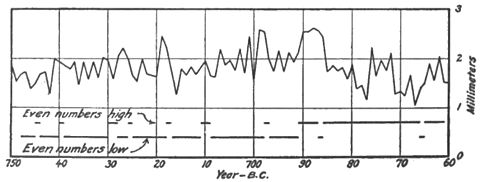immediately after their completion, and the period at once suggested the Bruckner cycle of 35 years. This interesting tree has been mentioned on pages 34 and 41.
A 2-year cycle — In the cross-identification of the trees used in this investigation, a constantly recurring feature has been a marked alternation in size of successive rings, giving them an appearance of being arranged in pairs. In the plotted curves this produces a zig-zag or see-saw effect. Usually such effect lasts a few years and then disappears or reverses, but the example illustrated in figure 39 shows unusual persistence. It is taken from D-22 from 750 B. C. to 660 B. C. The even dates show less growth than the odd almost continuously for 60 years, but for the next 30 years the reverse is the case. This is

Fig. 38.—Triple sunspot cycle in a single tree from northern Norway. Lower curve, a 34-year cycle.
evidently due to a short period of about 2 years in length. It has not yet been fully studied, but it is prominent in the European groups and in the Vermont group. It frequently shows a duration of a little less than 7 years in one phase, with odd dates greater in growth than even dates, and then for the next 7 years reverses its phase. This 14-year cycle is the series of beats the 2-year cycle produces by interfering with

Fig. 39.—D-22 at 760 to 660 B. C, showing a 2-year period.[1]
the exact annual and biennial effects in the tree. Hence, by a simple process, its length is found to be in effect frequently 21 or 28 months. Comparison has been made with the rainfall records near the Vermont group (Douglass, 1915:181) and a variable period has been found
- ↑ The corrections found in 1919 make these dates one year earlier.

